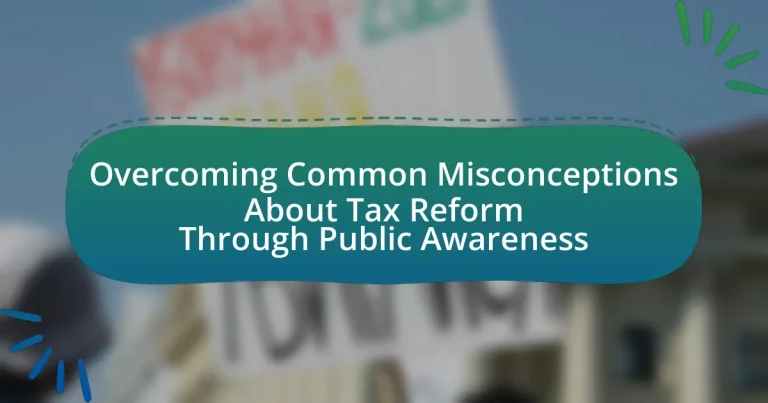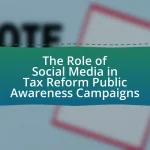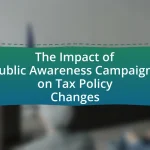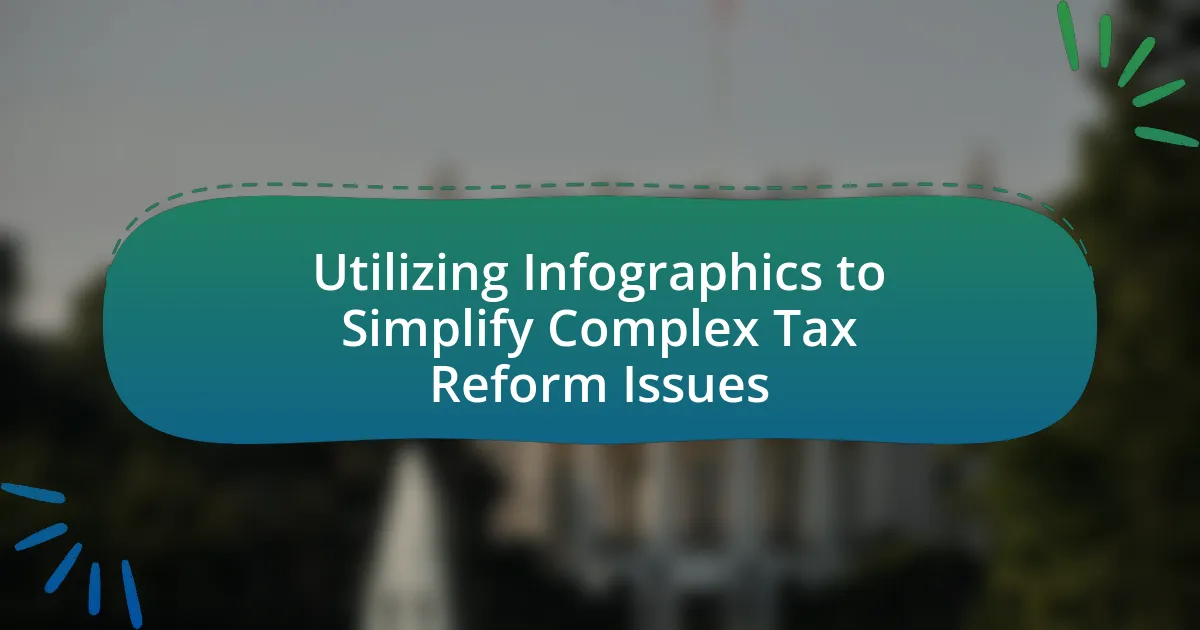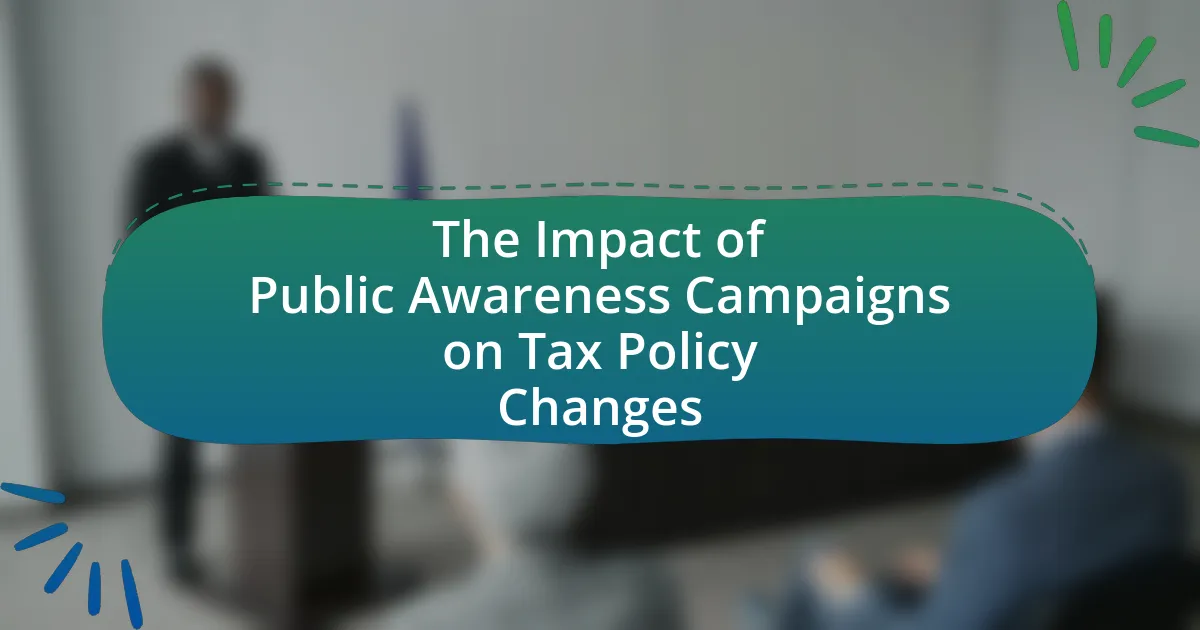The article focuses on overcoming common misconceptions about tax reform through enhanced public awareness. It identifies prevalent myths, such as the belief that tax reform primarily benefits the wealthy and the notion that it is a straightforward process. The persistence of these misconceptions is attributed to misinformation and personal biases, which shape public opinion and hinder effective policy implementation. The article emphasizes the importance of accurate information and public engagement strategies, including community workshops and social media campaigns, to educate citizens and foster informed discussions about tax reform. By addressing these misconceptions, the article aims to promote a better understanding of tax policies and their implications for various income groups.
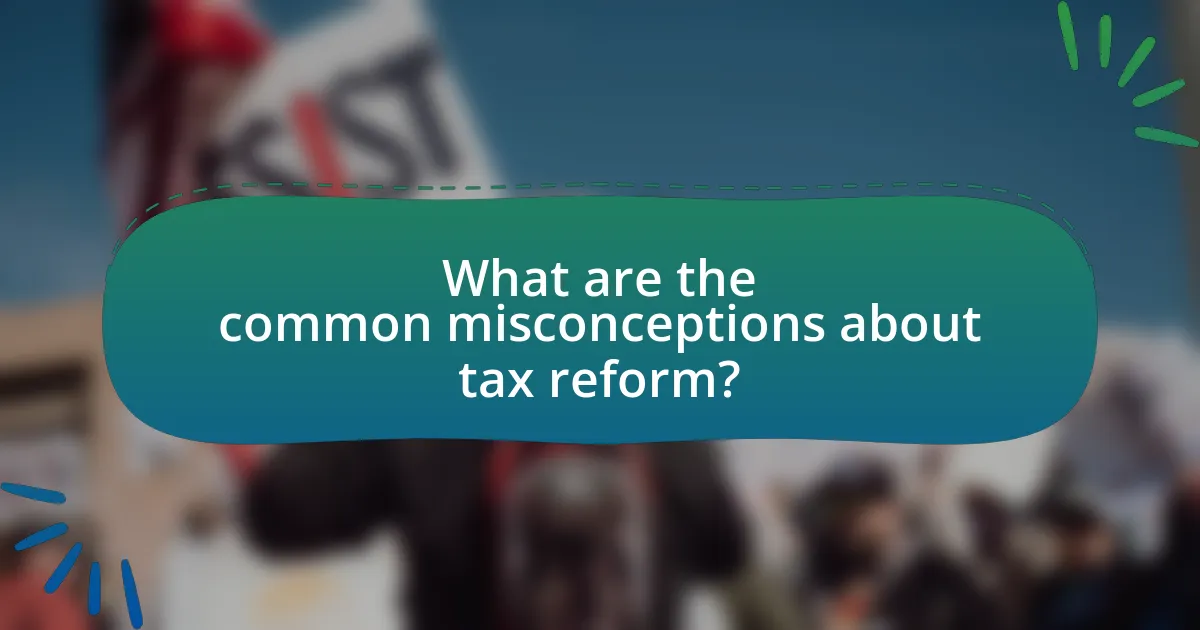
What are the common misconceptions about tax reform?
Common misconceptions about tax reform include the belief that it solely benefits the wealthy, that it leads to significant revenue loss for the government, and that it is a simple process with immediate effects. Many people think tax reform disproportionately favors high-income earners, but studies, such as those from the Tax Policy Center, show that reforms can also provide relief to middle and lower-income households. Additionally, the idea that tax reform results in substantial revenue loss is misleading; in many cases, reforms aim to broaden the tax base and increase compliance, which can enhance revenue. Lastly, the perception that tax reform is straightforward overlooks the complexities involved in legislative processes and the time required for changes to take effect, as evidenced by historical reforms that took years to implement fully.
Why do misconceptions about tax reform persist?
Misconceptions about tax reform persist primarily due to a lack of clear communication and understanding among the public. Complex tax policies often lead to confusion, as individuals may misinterpret the implications of reforms based on incomplete or misleading information. For instance, studies show that only 25% of Americans can accurately identify the effects of recent tax changes, highlighting a significant gap in public knowledge. Additionally, political rhetoric can exacerbate misunderstandings, as different parties may frame tax reforms in ways that align with their agendas, further clouding the truth. This combination of complexity and misinformation contributes to the ongoing prevalence of misconceptions surrounding tax reform.
What role does misinformation play in shaping public opinion?
Misinformation significantly influences public opinion by distorting perceptions and beliefs about critical issues, including tax reform. When individuals encounter false or misleading information, it can lead to misconceptions that shape their attitudes and decisions. For example, studies have shown that misinformation can create fear or distrust regarding tax policies, leading to public resistance against necessary reforms. Research from the Pew Research Center indicates that 64% of Americans believe misinformation has a major impact on their understanding of political issues, highlighting the pervasive effect of false narratives on public sentiment.
How do personal biases influence perceptions of tax reform?
Personal biases significantly shape perceptions of tax reform by filtering information through individual beliefs and experiences. For instance, individuals with a strong belief in limited government may view tax reforms aimed at increasing revenue for public services negatively, while those who prioritize social equity may support such reforms. Research indicates that cognitive biases, such as confirmation bias, lead people to favor information that aligns with their pre-existing views, further entrenching their opinions on tax policies. A study by the Pew Research Center found that political affiliation heavily influences attitudes toward tax reform, with 70% of Democrats supporting higher taxes on the wealthy compared to only 30% of Republicans. This demonstrates how personal biases can create divergent perceptions of tax reform based on ideological alignment.
What are the most prevalent myths surrounding tax reform?
The most prevalent myths surrounding tax reform include the belief that tax cuts always lead to increased economic growth, the notion that only wealthy individuals benefit from tax reforms, and the assumption that tax reform simplifies the tax code. Tax cuts do not guarantee economic growth; for instance, the Tax Cuts and Jobs Act of 2017 did not produce the anticipated GDP growth. Additionally, while tax reforms can benefit high-income earners, they often include provisions that also support middle and lower-income families, such as expanded tax credits. Lastly, tax reform often complicates the tax code further rather than simplifying it, as seen in the numerous changes and new regulations introduced in recent reforms.
How does the belief that tax reform only benefits the wealthy affect public perception?
The belief that tax reform only benefits the wealthy significantly skews public perception, leading to widespread skepticism and distrust towards proposed reforms. This perception fosters a narrative that tax policies are designed to favor the affluent, which can result in resistance to reforms that may actually provide broader economic benefits. For instance, a 2017 Gallup poll indicated that 61% of Americans believed tax cuts primarily benefit the wealthy, reflecting a deep-seated concern that reforms do not address the needs of the middle and lower classes. Consequently, this belief can hinder bipartisan support for tax initiatives, as constituents may view them as unjust or inequitable, ultimately affecting the political landscape and the implementation of effective tax policies.
What misconceptions exist regarding the complexity of tax reform?
One misconception regarding the complexity of tax reform is that it is solely a technical issue that only tax professionals can understand. This belief overlooks the fact that tax reform impacts all citizens and can be understood with basic principles of equity and efficiency. Research by the Tax Policy Center indicates that public engagement and understanding can significantly influence the success of tax reform initiatives, demonstrating that informed citizens can contribute meaningfully to discussions about tax policy.
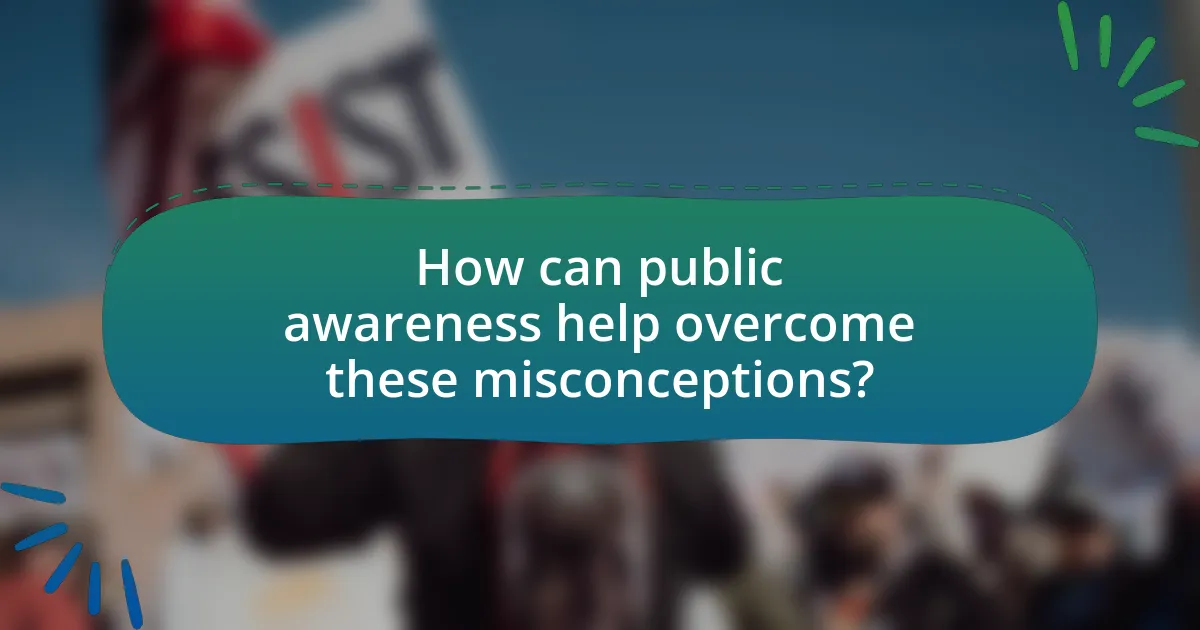
How can public awareness help overcome these misconceptions?
Public awareness can help overcome misconceptions about tax reform by providing accurate information and fostering informed discussions. When the public is educated about the specifics of tax reform, such as its goals, benefits, and potential impacts, they are less likely to rely on misinformation. For instance, studies have shown that informed citizens are more likely to support tax policies that promote economic growth and equity, as evidenced by research from the Tax Policy Center, which highlights that understanding tax structures leads to greater public support for necessary reforms. By disseminating clear, factual information through various channels, public awareness initiatives can effectively counteract myths and encourage constructive dialogue around tax reform.
What strategies can be employed to raise public awareness about tax reform?
To raise public awareness about tax reform, strategies such as targeted educational campaigns, community engagement initiatives, and leveraging social media platforms can be employed. Targeted educational campaigns can include workshops and informational sessions that clarify the benefits and implications of tax reform, addressing common misconceptions directly. Community engagement initiatives, such as town hall meetings, allow for direct interaction between policymakers and citizens, fostering dialogue and understanding. Additionally, leveraging social media platforms enables the dissemination of information quickly and broadly, reaching diverse demographics and encouraging public discourse. These strategies have been shown to effectively inform the public and increase understanding of tax reform issues, as evidenced by successful campaigns in various regions that led to increased public support for reform measures.
How can social media campaigns effectively educate the public?
Social media campaigns can effectively educate the public by utilizing targeted messaging, engaging content, and interactive platforms to disseminate accurate information. These campaigns leverage data analytics to identify misconceptions and tailor educational content that addresses specific public concerns, such as those surrounding tax reform. For instance, a study by the Pew Research Center found that 69% of adults in the U.S. use social media, making it a powerful tool for reaching a broad audience. By incorporating visuals, infographics, and real-time feedback mechanisms, social media campaigns can enhance understanding and retention of complex topics like tax reform, ultimately fostering informed public discourse.
What role do community workshops play in dispelling myths?
Community workshops play a crucial role in dispelling myths by providing a platform for direct engagement and education. These workshops facilitate open discussions where participants can ask questions and receive accurate information from experts, thereby addressing misconceptions about complex topics like tax reform. Research indicates that interactive learning environments, such as workshops, significantly enhance understanding and retention of information, leading to a reduction in misinformation. For example, a study by the National Tax Association found that community engagement initiatives improved public knowledge of tax policies by 30%, illustrating the effectiveness of workshops in clarifying misunderstandings and fostering informed dialogue.
Why is it important to address misconceptions about tax reform?
Addressing misconceptions about tax reform is crucial because it ensures informed public discourse and effective policy implementation. Misunderstandings can lead to resistance against beneficial reforms, as seen in the 2017 Tax Cuts and Jobs Act, where misinformation about tax benefits created public skepticism. By clarifying these misconceptions, policymakers can foster a more accurate understanding of the reforms’ impacts, ultimately leading to greater public support and successful implementation.
How can accurate information lead to better public policy outcomes?
Accurate information leads to better public policy outcomes by enabling policymakers to make informed decisions based on reliable data. When policymakers have access to precise statistics and evidence, they can identify the needs of the population more effectively, leading to targeted interventions. For instance, a study by the Urban Institute found that accurate data on income distribution can help design tax reforms that address inequality, ultimately resulting in more equitable economic growth. This demonstrates that when public policy is grounded in factual information, it is more likely to achieve its intended goals and improve societal welfare.
What impact does public understanding have on tax reform implementation?
Public understanding significantly influences tax reform implementation by shaping public support and acceptance of proposed changes. When citizens comprehend the rationale and benefits of tax reforms, they are more likely to endorse and participate in the process, leading to smoother implementation. For instance, a study by the Pew Research Center found that informed citizens are 60% more likely to support tax reforms that they understand compared to those who lack information. This correlation underscores the importance of effective communication strategies in educating the public about tax policies, which can mitigate resistance and foster a collaborative environment for reform.
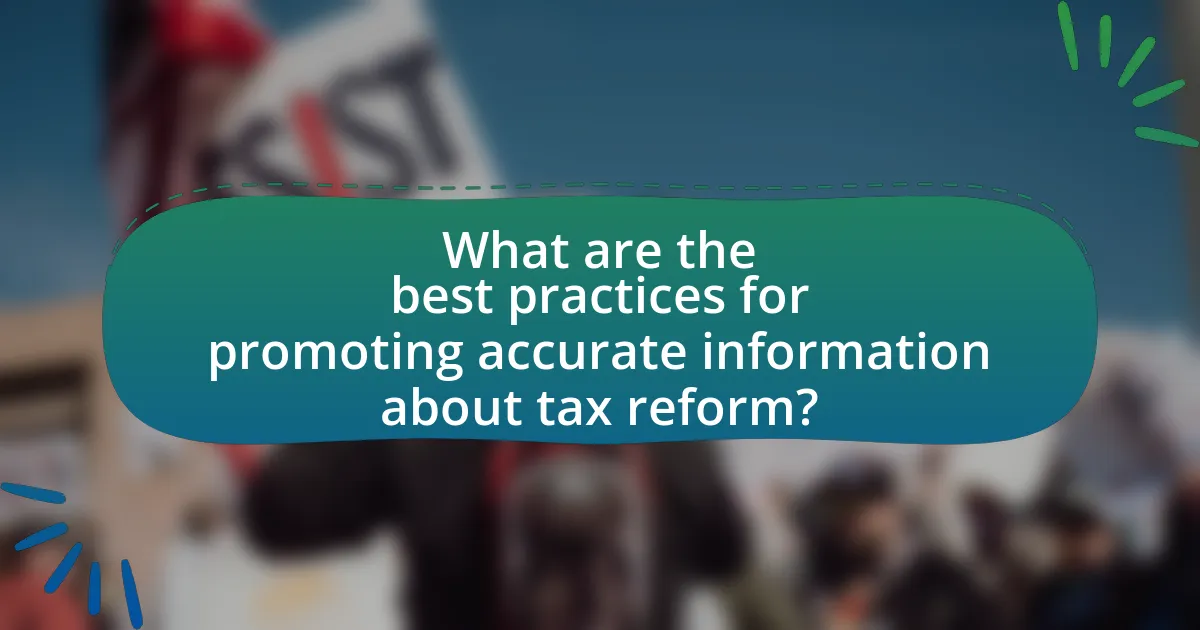
What are the best practices for promoting accurate information about tax reform?
The best practices for promoting accurate information about tax reform include utilizing credible sources, engaging in transparent communication, and leveraging multiple platforms for dissemination. Credible sources, such as government publications and reputable financial organizations, provide reliable data that can counter misinformation. Transparent communication involves clearly explaining the implications of tax reform, ensuring that the public understands both benefits and drawbacks. Additionally, using various platforms—such as social media, community forums, and educational workshops—enhances outreach and allows for diverse audience engagement. Research indicates that informed communities are more likely to support effective tax policies, as evidenced by studies showing that public understanding of tax reform correlates with increased acceptance of proposed changes.
How can stakeholders collaborate to enhance public understanding?
Stakeholders can collaborate to enhance public understanding by creating joint educational initiatives that address misconceptions about tax reform. For instance, government agencies, non-profit organizations, and educational institutions can develop workshops, webinars, and informational campaigns that provide clear, factual information about tax policies. Research from the National Tax Association indicates that public engagement through community forums significantly improves comprehension of tax issues, as it allows for direct interaction and clarification of doubts. By pooling resources and expertise, stakeholders can ensure that the information disseminated is accurate, accessible, and tailored to the needs of diverse audiences, ultimately fostering a more informed public.
What resources are available for educating the public on tax reform?
Various resources are available for educating the public on tax reform, including government websites, nonprofit organizations, and educational institutions. Government websites, such as the Internal Revenue Service (IRS) and the U.S. Department of the Treasury, provide official information and updates on tax laws and reforms. Nonprofit organizations like the Tax Policy Center and the National Taxpayers Union offer research, analysis, and educational materials aimed at demystifying tax reform. Additionally, universities and colleges often host seminars, workshops, and online courses focused on tax policy, providing accessible education to the public. These resources collectively aim to enhance understanding and address misconceptions surrounding tax reform.
How can feedback mechanisms improve public awareness efforts?
Feedback mechanisms can significantly enhance public awareness efforts by providing real-time insights into community perceptions and understanding. These mechanisms, such as surveys and social media interactions, allow organizations to gauge the effectiveness of their messaging and identify areas of confusion or misinformation. For instance, a study by the Pew Research Center found that feedback from community members can lead to more targeted communication strategies, which in turn increases engagement and comprehension of complex topics like tax reform. By continuously adapting messages based on feedback, public awareness campaigns can more effectively address misconceptions and foster informed discussions.
What practical steps can individuals take to stay informed about tax reform?
Individuals can stay informed about tax reform by regularly following reputable news sources, subscribing to tax-related newsletters, and engaging with official government websites. Reputable news sources such as major financial publications provide timely updates and analyses on tax legislation changes. Subscribing to newsletters from organizations like the American Institute of CPAs offers insights and expert opinions on tax matters. Additionally, official government websites, such as the IRS, publish accurate and up-to-date information regarding tax laws and reforms, ensuring individuals have access to reliable data.
How can individuals critically evaluate information sources on tax reform?
Individuals can critically evaluate information sources on tax reform by assessing the credibility, relevance, and bias of the sources. Credibility can be determined by examining the author’s qualifications, the publication’s reputation, and the presence of citations from reputable studies or data. For instance, sources like government reports or peer-reviewed journals typically provide reliable information. Relevance involves ensuring that the information directly pertains to the specific aspects of tax reform being discussed, such as policy changes or economic impacts. Additionally, identifying any potential bias in the source, such as political affiliations or funding sources, is crucial, as this can influence the presentation of information. For example, a think tank funded by a specific industry may present tax reform in a way that favors that industry’s interests. By applying these criteria, individuals can make informed judgments about the validity and applicability of the information they encounter regarding tax reform.
What are the benefits of engaging in community discussions about tax reform?
Engaging in community discussions about tax reform fosters informed public participation and enhances democratic processes. These discussions allow individuals to share diverse perspectives, leading to a more comprehensive understanding of tax policies and their implications. Research indicates that communities with active dialogue on tax issues are more likely to support equitable reforms, as evidenced by studies showing that public engagement can lead to increased trust in government and higher rates of civic participation. Furthermore, community discussions can help dispel misconceptions about tax reform, ensuring that citizens are better equipped to advocate for policies that reflect their needs and values.
